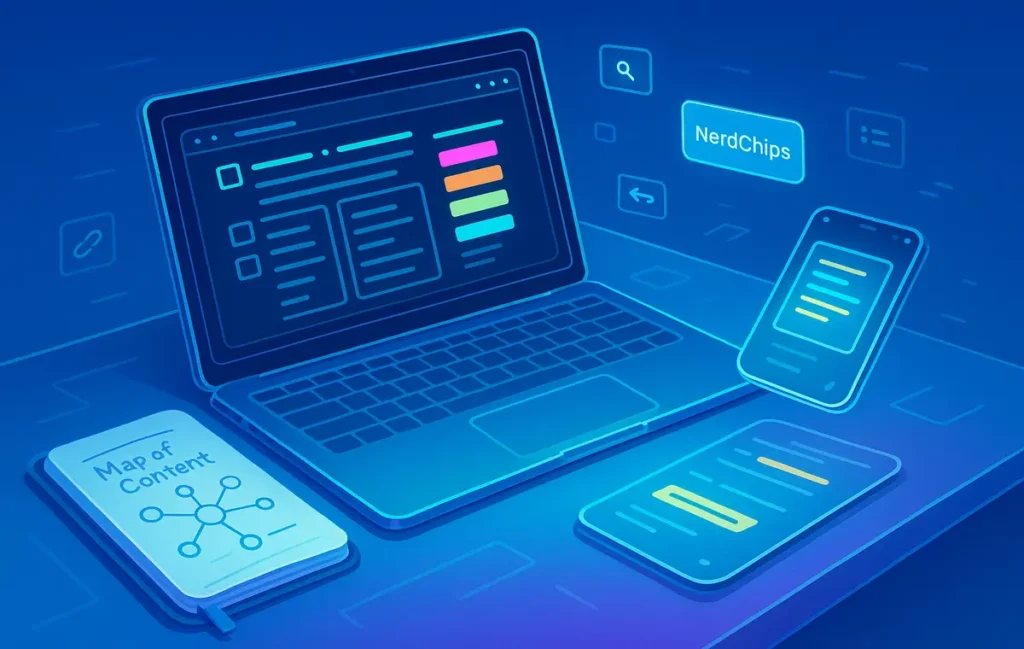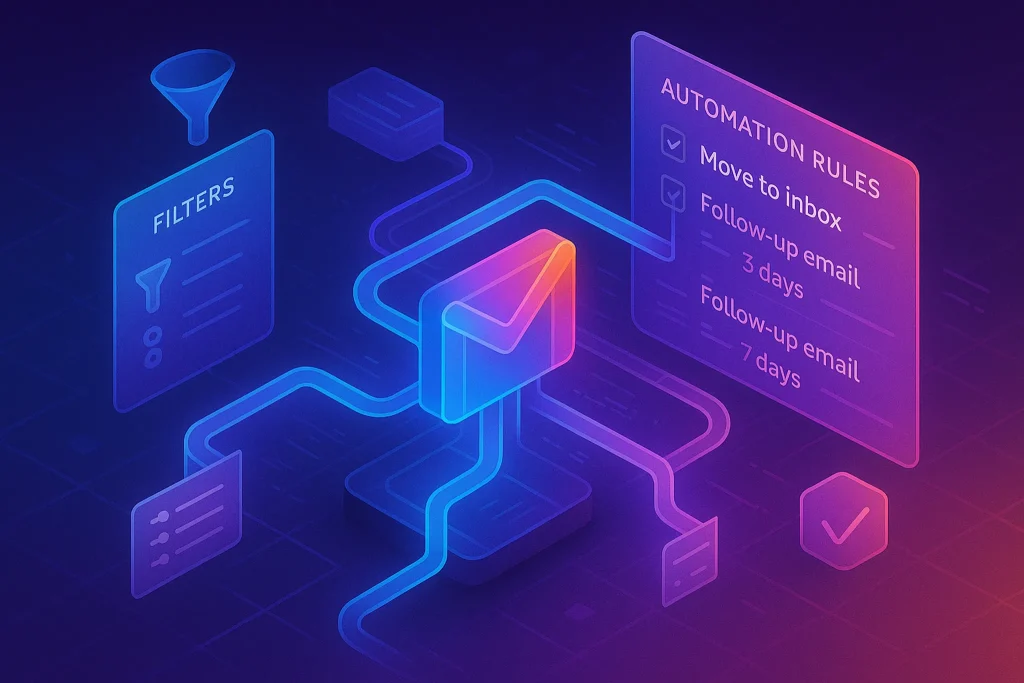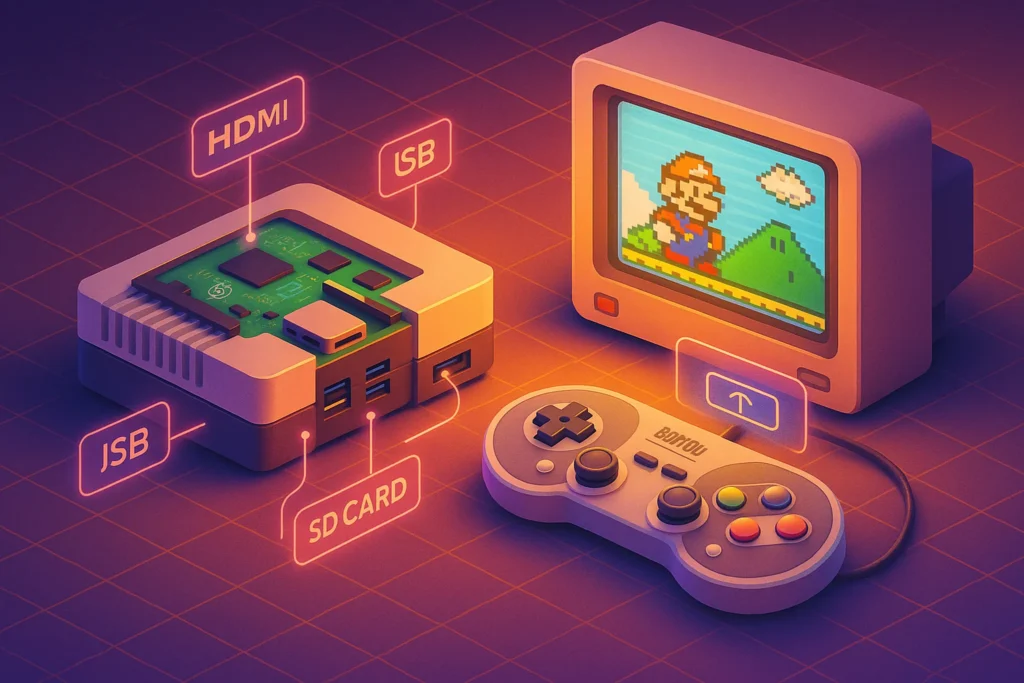📚 Intro
Information floods in from every direction—feeds, PDFs, podcasts, meetings, and late-night ideas typed into your phone. Winners in 2025 aren’t the people who consume the most; they’re the ones who can capture, connect, and retrieve precisely when it counts. That’s why a Personal Knowledge Hub matters. It’s not another shiny app; it’s a system that turns raw info into reusable insight you can deploy for content, decisions, and career-defining projects.
If you’ve flirted with note-taking before but fell off, you’re not alone. The mental tax of scattered tools is real. The goal here isn’t to build an ornate “second brain” you never open; it’s to design a lightweight, durable hub that gets faster the more you use it. As you read, you’ll see natural places to plug in NerdChips’ deeper resources—like our Ultimate Guide to Building a Second Brain (Digital Note-Taking) for conceptual grounding, or How to Organize Your Digital Life when you’re ready to clean up your files, tabs, and inbox to feed your hub clean inputs.
💡 Nerd Tip: Treat this guide like a recipe. Build a basic version in a weekend, then iterate with tiny improvements each week. Momentum beats perfection.
🧭 What Is a Personal Knowledge Hub?
A Personal Knowledge Hub is a single, coherent system for how you collect and reuse knowledge. It blends note-taking, content curation, and fast retrieval so you can move from “I think I read something about this…” to “Here are three relevant highlights, two related notes, and a template I can reuse—now.”
Think of it as your private library + workshop. Library shelves hold sources (articles, books, clips). Workbenches hold working notes (ideas, drafts, decisions). The magic is the paths between them: links, tags, saved searches, and dashboards that surface what you need on demand. If you want the philosophy behind building a thinking system, bookmark Second Brain Systems; for this piece we’ll stay ruthlessly practical so you can ship a working hub quickly.
Two guardrails keep this useful. First, app-agnostic thinking: your structure shouldn’t collapse if you switch from Notion to Obsidian. Second, retrieval-first design: don’t save what you can’t easily find. Organize for your future self—the one in a hurry before a meeting.
🎯 Why You Need One (Beyond the Hype)
Most of us forget the majority of what we read within days. That’s fine—until you need that key stat, quote, or workflow at 4:55 PM. A hub compresses the distance from question to answer. Over time, it compounds: every highlight you capture and connect becomes a force multiplier for the next task. Content creators produce faster because reusable B-roll of ideas sits ready. Students synthesize sources into sharper essays. Operators make decisions with traceable reasoning instead of vibes.
There’s also a sanity benefit. When your inputs funnel into a known place, cognitive overhead drops. You stop “re-deciding” where things go. A saved search brings back last year’s marketing experiments in two clicks. Your template for a research memo fills in, and the structure nudges you to think more clearly. If you want a step-by-step process for decluttering upstream—files, email, and tabs—read How to Organize Your Digital Life right after you finish this guide; clean inputs make hubs sing.
💡 Nerd Tip: The metric that matters isn’t how many notes you take; it’s time-to-retrieval. If you can’t find it fast, it isn’t knowledge—it’s digital attic.
🧱 Step 1: Choose Your Core Platform
You need one home base. Popular choices: Notion, Obsidian, Roam Research, and Logseq. Notion shines at structure, databases, and clean collaboration. Obsidian is a Markdown-first vault with bidirectional links and a thriving plugin ecosystem. Roam and Logseq are daily-notes-centric and great for associative thinking. If you’re a student, our Best AI Note-Taking Apps for Students compares quick capture, transcripts, and study workflows; you can borrow the capture pieces even if your main hub lives elsewhere.
Pick based on how you think. If you love spreadsheets and project dashboards, Notion feels native. If you’re a writer who lives in text and keyboard shortcuts, Obsidian’s frictionless files will feel like home. If your best ideas appear while graphing connections, Roam/Logseq’s page references are delightful. Don’t over-optimize. The right app is the one you’ll open daily.
Platform Snapshot (Keep It Simple)
| Platform | Strengths | Watch-outs | Best For |
|---|---|---|---|
| Notion | Databases, templates, shared workspaces | Can sprawl; offline quirks | Structured dashboards, teams |
| Obsidian | Speed, plaintext, plugins (Dataview) | Plugin temptation overload | Writers, researchers, local-first |
| Roam | Graph thinking, backlinks by default | Price, steeper learning curve | Explorers of ideas, Zettelkasten |
| Logseq | Open-source, local-first graph | Occasional rough edges | Privacy-first graph note-takers |
You can’t go wrong. Commit to one for 90 days, then reassess.
🗺️ Step 2: Define a Framework You’ll Stick To
Frameworks give your hub a stable spine. The two classics are PARA and Zettelkasten, and many pros blend them.
PARA—Projects, Areas, Resources, Archives—organizes by actionability. “Projects” are time-bound outcomes (Launch v2 website). “Areas” are ongoing commitments (Health, Finances, DevRel). “Resources” hold reusable knowledge (Marketing heuristics, Python snippets). “Archives” is the quiet basement. PARA’s strength is retrieval: when you’re doing a project, relevant resources sit close by.
Zettelkasten organizes by ideas. Notes are atomic—one thought per note—and linked. Over time, networks of related ideas form emergent maps you can browse. This is brilliant for research, writing, and any field where synthesis beats tasks.
A hybrid works beautifully: run PARA at the folder/database level (what’s active), then use Zettelkasten-style links inside notes to connect concepts. Our Ultimate Guide to Building a Second Brain (Digital Note-Taking) walks through both mental models so you can choose deliberately.
💡 Nerd Tip: Name notes for retrieval. “AI-meeting-note-prompting-2025-03” is better than “Meeting 18.” Your future self searches by nouns and time windows.
⚡ Step 3: Capture Information Effortlessly
Capture is your intake valve. Make it two taps from idea to inbox. On the web, use clippers or a read-it-later tool like Pocket or Readwise; highlights sync into your hub automatically. On mobile, create Quick Add shortcuts: dictate a thought, append to Daily Notes, tag once, done. For meetings and lectures, a lightweight recorder (or an AI note tool from Best AI Note-Taking Apps for Students) produces transcripts you can summarize into atomic notes later.
Avoid the trap of hoarding. You don’t need to save the entire internet. Capture when there’s a clear reason: you’ll reuse the table, you’ll quote the stat, or it sparks a connection to a current project. A small comment next to a highlight—“use for launch email #2”—beats 50 raw clippings you never revisit.
Two-Minute Capture Recipe
-
Clip/screenshot → add a one-line reason you saved it
-
Tag once for the current project or area
-
Schedule processing during weekly review, not now
💡 Nerd Tip: Create a “Cold Storage” tag. Anything you haven’t touched after 60 days moves there automatically. It keeps your active lists honest.
🧭 Step 4: Organize for Retrieval (Tags, Links, and Saved Searches)
Folders feel comfortable, but they’re rigid. Tags are flexible, but chaos if ungoverned. Links are where ideas breathe. Use all three, lightly.
Start with PARA at the top. Inside Projects and Areas, keep short pages with index links to the resources they depend on. Maintain a 5–7 tag taxonomy you’ll remember under pressure (e.g., #framework, #stat, #quote, #template, #example, #question). In Obsidian/Roam, aggressively backlink related notes; in Notion, use relation properties to connect ideas across databases.
Saved searches are underrated. Build queries like “tag:template updated:90d” or “#stat within Project: Pricing.” Pin them to your sidebar. That way, you retrieve by intent, not by memory. When you’re ready to declutter upstream, the patterns in How to Organize Your Digital Life help you reduce noise so only signal flows in.
💡 Nerd Tip: Create one “Now” view per project: recent notes, open questions, and the 3 most linked resources. If it isn’t visible there, it might as well not exist.
🔗 Step 5: Connect & Grow Knowledge (From Notes to Insight)
Connections are where a hub outperforms a notebook. As you process highlights, ask “Where does this live?” and “What does this connect to?” A tactic that works: create Idea Stubs—tiny notes with a claim and two links. They’re cheap to make and grow over time. When you collect five or more around a pattern, promote them to a MOC (Map of Content) page. Now you have a living outline for a talk, article, or decision memo.
For creators, a connected hub is a content engine. A highlight from a book links to your Hook Templates page; two weeks later, it becomes the opener of a newsletter. Operators benefit too: your Decision Logs link to outcomes, making post-mortems faster. Want to tie relationships into your knowledge? Build a lightweight Personal CRM alongside your hub using our guide How to Build a Personal CRM System Using Notion so meeting notes and follow-ups live in the same universe.
💡 Nerd Tip: Every time you save a quote, add a one-sentence “Why it matters”. Opinionated notes become publishable building blocks.
🔁 Step 6: Review & Evolve Without Burning Out
A hub thrives on gentle pruning. Set a recurring Weekly Review to process the inbox, promote notes to projects, and archive stale items. It’s 30–40 minutes that keep entropy low. Each month, run a MOC tune-up: merge duplicates, rename vague titles, and kill zombie tags you never use. Twice a year, revisit your framework: do Projects/Areas still fit your work, or did a new Area emerge?
Protect energy. Reviews are for decisions, not chores. If a note doesn’t spark a connection, mark it “Cold Storage” and move on. If a project grows messy, create a new “Now” page and relink only what you truly need. Minimalist maintenance keeps the hub fast and emotionally light.
Weekly Review Checklist
-
Empty inbox and assign notes to Projects/Areas
-
Promote 3 useful notes with links and a “Why it matters” line
-
Refresh Now views for active projects
-
Archive 1 tag or page you don’t use
Ready to Build a Knowledge Hub That Pays You Back?
Start with a Notion or Obsidian core, add Readwise for highlights, and ship your first Map of Content this weekend. Future-you will thank you.
🧰 Tools to Supercharge Your Hub (Without Overkill)
Readwise is the glue for highlights across Kindle, web, and podcasts; the auto-sync into Notion or Obsidian prevents manual copy/paste rot. Notion AI or Obsidian’s Text Generator plugin can condense transcripts into first-pass summaries; use them to shorten, not to invent. Plugins like Dataview (Obsidian) turn your vault into a queryable database: “show notes tagged #stat edited in the last 14 days.” Meanwhile, Templater and QuickAdd make capture and daily notes ergonomic.
Be honest about AI. It excels at classification, summaries, and formatting; it struggles with nuance and can hallucinate citations. Use it as a librarian, not an author. Our primer on thinking systems, Second Brain Systems, sketches when to automate and when to lean on deliberate human judgment.
💡 Nerd Tip: Create an “AI Guardrails” page in your hub: what you’ll automate, what you’ll never automate, and a short checklist to verify AI outputs before they pollute your notes.
🧪 A Weekend Build: Notion-Centric Hub from Zero to Working
Friday evening: Create four top-level databases: Notes, Projects, Areas, Resources. Add simple properties—Tags, Source, Links, Status. In Notes, build three templates: “Literature Note,” “Meeting Note,” and “Idea Stub.” Add a “Why it matters” field to each. In Projects, include Goal, Next Actions, and a linked view of related Notes.
Saturday: Connect Readwise (or your clipper of choice). Skim your last week of highlights and process just ten into Literature Notes with a one-line summary and two links each. Build a Home dashboard with: (1) Projects Now View, (2) Today’s Notes, (3) Inbox, and (4) a “Random resurfacing” widget that shows one note edited 90+ days ago. Between sessions, read Ultimate Guide to Building a Second Brain to refine your templates.
Sunday: Draft your first MOC from five Idea Stubs that rhyme. Add a Review page with your weekly checklist and a link to How to Organize Your Digital Life so you can clean upstream inputs next week. Finally, build a simple People database (your Personal CRM starter) with a relation to Notes, then bookmark How to Build a Personal CRM System Using Notion to expand it later. By Sunday night, you’ll have a living hub with one reliable path from capture → connection → retrieval.
💡 Nerd Tip: Ship version 0.1 without fancy icons or colors. Decoration comes after reliability.
🔐 Security, Privacy, and Portability
Knowledge is leverage—protect it. If you’re cloud-first, enable two-factor auth and export templates quarterly. Local-first users should keep offsite backups (encrypted) and test restores twice a year. Sensitive notes deserve separate vaults or databases with stricter sharing; don’t let your default workspace be the only gate. For portability, prefer open formats (Markdown, CSV exports) so your knowledge survives app churn.
Decide retention early. Meeting recordings? Auto-delete after 90 days unless tagged #keep. Personal journaling? Local-only. And if you use AI features, understand where processing happens. If a feature requires sending sensitive text to external servers, create a redaction rule or opt out.
💡 Nerd Tip: Add a “What if I disappear?” page. It lists how a trusted person can access your hub in an emergency, without handing them everything today.
🧩 Common Pitfalls & Practical Fixes
Capture sprawl. You’re saving too much because saving feels productive. Fix: write a one-line use case next to each capture or don’t save it. Your future self will thank you.
Framework thrash. Switching systems weekly erases the compounding effect. Fix: commit to one framework for 90 days. Put the alternative on a list called “Q2 experiments.”
Tool fatigue. Ten apps do a little each, and none integrates. Fix: designate one Core Hub (Notion/Obsidian) and one Capture Assistant (Readwise/Pocket). Everything else must feed those or be removed.
“I still can’t find things.” Your structure is fine; your naming isn’t. Fix: rename to searchable nouns, add date prefixes for context, and rely on saved searches. Also, keep your Now views ruthless—only what helps the next decision belongs there.
If you want a detailed playbook for creating clean inputs that keep your hub healthy, circle back to How to Organize Your Digital Life. Upstream hygiene turns downstream retrieval into a joy.
📬 Want More Smart Workflow Guides?
Join our free newsletter and get weekly insights on AI tools, no-code workflows, and PKM systems—field-tested by NerdChips and delivered to your inbox.
🔐 100% privacy. No noise. Just value-packed tips from NerdChips.
🧠 Nerd Verdict
A Personal Knowledge Hub is leverage you build once and cash in forever. The hard part isn’t choosing the perfect app; it’s committing to a simple path from capture to connection to retrieval and walking it every day. Start with a core platform, adopt a framework you trust, ship one Map of Content, and guard your weekly review. Tools evolve, but a retrieval-first habit compounds for years. From the NerdChips perspective, the people who win in the next decade aren’t drowning in information—they’re compounding insight.
❓ FAQ: Nerds Ask, We Answer
💬 Would You Bite?
If you were starting this weekend, would you build your core hub in Notion for structure or Obsidian for speed and local control—and what’s the first project you’d feed it?
Crafted by NerdChips for creators and teams who want their best ideas to travel the world.



